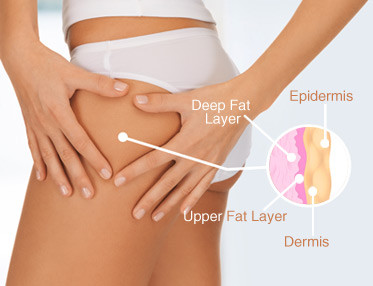The best way to start any battle is to have a good understanding of the enemy. In this case we are talking about Adiposis Edematoua, Dermopanniculosis Deformans, Status Protrusus Cutis or as it is most commonly known, cellulite.

We use this name to describe skin that has become lumpy or pitted due to fatty deposits near the surface of the skin. These deposits of fat are rare to find in men and are most common in females after puberty. Thighs, buttock, pelvic area, and even the stomach area can all fall victim to cellulite. The vertical makeup of the cells that contain subcutaneous fat makes it possible for fat to push up to the surface for a variety of reasons which we will discuss next.
Main Causes of Cellulite
- Genetic Factors – yes, you can be predisposed to cellulite. Predisposition can be passed from mother to daughter and is found to be more common in some ethnic groups. Caucasian or white women face the highest risk, however cellulite is found in all groups.
- Metabolism – a slowing metabolism will mean your body is using less fuel (fat) causing excess fuel (fat) to build in the subcutaneous layers.
- Dieting too much or too hard is actually bad for you, whilst a regular, healthy diet is good. Losing excess weight can help, since this can exacerbate cellulite. Fluctuating weight and dieting significantly reduces skin elasticity; allowing cellulite to become more defined.
- Hormonal factors have a great effect on the skin as well. Estrogen, insulin, thyroid hormones, and protactin all can play a role in the formation of cellulite. While it is not yet proven, many doctors feel that high estrogen levels may actually initiate cellulite.
- Stress can also play a part in gaining more cellulite. Stress can increase catecholamines to high levels in your body: leading to cellulite.
 The good news is that some of these things are within our power to change. Let’s start with your metabolism. Many doctors agree and studies show that you can increase your metabolism with a strength training work out just twice a week. This will allow your body to burn more excess fat and help reduce the look of cellulite.
The good news is that some of these things are within our power to change. Let’s start with your metabolism. Many doctors agree and studies show that you can increase your metabolism with a strength training work out just twice a week. This will allow your body to burn more excess fat and help reduce the look of cellulite.
Many hormonal factors can be discussed with your doctor and may be as simple as a prescription. You may also use natural methods to affect your hormones and general wellbeing.
Lifestyle changes can help a lot too by trying to reduce stress in a daily routine. Once again this can be affected by exercise and diet. And we must remember not to crash diet or get on a diet cycle that only increases our odds of developing cellulite.
Although these steps help with better health and may reduce the appearance of cellulite, at this time there is no real cure. Many ladies will choose Cellulite Subcision surgery as a viable opposition to living with cellulite. This is the only real treatment for cellulite, but it also has not been proven in any long term study. Cellulite subcision is also the most invasive of treatments. In a nutshell your surgeon will slide a tool around under your skin cutting at the connective bands pulling down on the skin and thus relieving pressure and reducing the look of dimples in the affected skin. Such surgery can be very costly and there are definitely risks and dangers involved.
Alternatively, you can seek natural cellulite treatment guides like Truth About Cellulite which teaches you the symulast method.
Last but not least on our list would be fat grafting. Basically your doctor will take fat from one part of your body and inject it into the dimples of your cellulite to make a smoother you. However this can be a temporary fix as the body can reabsorb the fat cells over time. The effectiveness of this procedure is directly applied to the skill of your surgeon. You are not alone, 85 to 98% percent of all women are battling this problem but overall health needs to be your main concern.